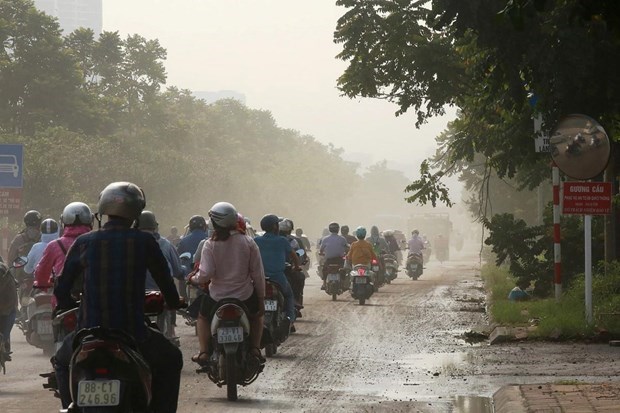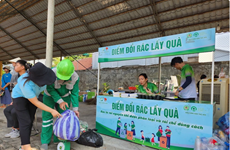Vietnam strives to eliminate substances harmful to ozone layer
Hanoi (VNA) - After 25 years of implementing the Montreal Protocol roadmap on schedule, Vietnam has reduced 10 percent of consumption of substances harmful to the ozone layer, especially HCFC substances.
 Vietnam is reported to have cut hundreds of thousands of tonnes of substances harmful to the ozone layer (Photo: VietnamPlus)
Vietnam is reported to have cut hundreds of thousands of tonnes of substances harmful to the ozone layer (Photo: VietnamPlus)
The information was announced by Deputy Minister of Natural Resources and Environment Le Cong Thanh at a ceremony to mark the International Day for the Preservation of the Ozone Layer in 2019 jointly hosted by the Ministry of Natural Resources and Environment, the United Nations Environment Programme and the World Bank (WB) in Hanoi on September 16.
Over the last 25 years, Vietnam has completely stopped the use of ozone depleting substances such as CFC, Halon, and CTC; and the pure HCFC-141b - the substance used in producing styrofoam. Besides, the use of Methyl Bromide was prohibited for applications apart from purposes for quarantining exports.
Reducing 10 percent of consumption of substances harmful to ozone layer
Thanh said along with joint efforts by the international community to protect the ozone layer, after 32 years of implementing the Montreal Protocol, 99 percent of substances harmful to ozone layer in refrigerators, air conditioners and many other products were eliminated, contributing to adapting to climate change.
In January 1994, Vietnam became one of the first countries to join the Vienna Convention for the Protection of the Ozone Layer and the Montreal Protocol on Substances that Deplete the Ozone Layer.
The country was committed to abiding by the provisions of the convention and protocol.
Over the past 25 years, Vietnam has actively participated in protecting the ozone layer and achieved results that were recognised by the international community.
Vietnam has eliminated the consumption of CFC, Halon, and CTC since January 1, 2010 and completely stopped the use of HCFC-141b and Methyl Bromide since January 1, 2015, in line with the roadmap set in the protocol. As a result, the country fulfilled its obligation to eliminate 10 percent of the HCFC consumption.
In addition to efforts to successfully eliminate substances that deplete the ozone layer, Vietnam still faces new challenges related to the increasing use of substances with high global warming potential such as Hydrofluorocarbon (HFC), which is used to replace ozone depleting substances in manufacturing refrigeration equipment and automotive air conditioners, and in extinguishing fire.
In line with the roadmap set in the protocol, developing countries, including Vietnam, will stop the consumption of HFCs at the basic level from 2024. By 2045, the consumption of HFCs will be reduced by 80 percent compared to the basic consumption.
As a developing country greatly affected by climate change, Vietnam has shown its high efforts in protecting the ozone layer, contributing to mitigating impacts of climate change in order to realize the objectives of the Montreal Protocol and the UN Framework Convention on Climate Change.
According to Deputy Minister Thanh, on September 4, 2019, the Government issued a resolution to officially approve the Kigali Amendment to the Montreal Protocol on Substances that Deplete the Ozone Layer. In the coming time, the Ministry of Natural Resources and Environment will closely coordinate with relevant ministries, agencies and international organizations in implementing the approved Kigali Amendment.
While highly valuing Vietnam’s efforts in recent times, Caitlin Wesen - UN Resident Coordinator and UNDP Resident Representative to Vietnam said Vietnam became the 82nd country to approve the Kiagali Amendment, contributing to controlling and eliminating substances with high global warming potential.
She called for cooperation among governments across the world, coordination among ministries, sectors and localities, and involvement of international partners, and especially enterprises operating in related areas, to address the challenge.
She pledged to work closely with Vietnam to successfully implement the Montreal Protocol and focus on the Kiagali Amendment in the time to come, saying that these activities will create co-benefits in the fight against climate change in Vietnam, and are the key to realize sustainable development goals as well as the 2030 Agenda.
 Caption: Almost all districts of Hanoi recorded polluted air on September 15 (Photo: VNA)
Caption: Almost all districts of Hanoi recorded polluted air on September 15 (Photo: VNA)
Supporting enterprises in technology change
In the framework of the ceremony, the Ministry of Natural Resources and Environment launched the second phase of the “National Management Plan for eliminating HCFC substances of Vietnam” (HPMP II) project.
Tang The Cuong, Director of the Climate Change Department under the ministry, said the project is carried out from 2018 to 2023, aiming to eliminating 35 percent of the basic consumption of HCFC.
It will support over 80 enterprises in replacing technology, aiming to reduce consumption of 1,000 tonnes of HCFC-22, and completely eliminate HCFC-141b in pre-blended polyols for producing insulating Styrofoam.
State-owned enterprises will also be supported in building, popularizing and guiding the application of regulations and techniques to eliminate HCFCs in accordance with the Montreal Protocol.
The project will also help improve State management agencies’ capacity in managing and eliminating HCFCs.
This is also the basis for Vietnam to complete the project’s third phase for the 2023-2030 period to submit to the Multilateral Fund for considering funding the complete elimination of HCFC consumption on schedule.
According to an UN report in 2018, ozone in parts of the stratosphere has recovered at a rate of 1-3 percent since 2000 and, at projected rates, Northern Hemisphere and mid-latitude ozone is scheduled to heal completely by the 2030s, followed by the Southern Hemisphere in the 2050s and polar regions by 2060.
Efforts to protect the ozone layer have helped to avert an estimated 135 billion tonnes of carbon dioxide equivalent (CO2eq) emissions between 1990-2010./.













